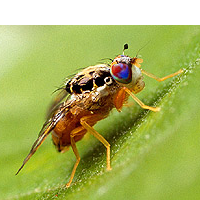Study Says Lurking Fruit Flies Are Poised to Ravage California Crops
 Mediterranean fruit fly
Mediterranean fruit fly
Although California has maintained an ever-vigilant stance against destructive fruit flies sneaking into the state since they were first detected in the 1950s, a new report indicates we should be more worried about the enemy within.
“Despite the 250+ emergency eradication projects that have been directed against these pests by state and federal agencies, a minimum of five and as many as nine or more tephritid species are established and widespread,” researchers warned in a study published this week in Proceedings of the Royal Society B.
That includes the Mediterranean, Mexican and oriental fruit flies, and maybe the peach, guava and melon fruit flies. They threaten California’s $43.5 billion agricultural industry, which has to worry about, in addition to battling outbreaks in the field, a perception by importers that the state’s crops are infested that could result in embargoes.
The state periodically declares a bug alert when fruit flies are detected, embarking on various schemes of eradication that can include spraying, baiting traps and releasing sterile fruit flies into the environment. But state officials generally regard each infestation as coming from outside California.
Dr. Robert Leavitt, director of plant health at the California Department of Food and Agriculture, told the Associated Press the state still believes that and evidence that the fruit flies have gained a somewhat permanent foothold isn’t going to change how the problem is dealt with.
Fruit flies are thought to enter the state on cargo ships or via travelers from other areas, but one of the study’s co-authors, James Carey from the University of California, Davis, said a review of data dating back to 1950 contradicts that. He told the AP that the state and nation needed long-term plans to eradicate the existing fly populations in addition to the prevention measures they already take.
“The long-term consequences of making short-term policy decisions based solely on the legal definition of eradication, while ignoring the biological reality (i.e. fruit fly establishment and spread), are potentially quite serious,” the report said.
Carey described the state’s situation in a more colorful fashion:
“They're here, they're established and lurking. It's like an insidious cancer that's just metastasizing and spreading, and it will eventually develop into a full-fledged cancer.”
–Ken Broder
To Learn More:
Fruit Flies Could Devastate California Crops “Like an Insidious Cancer” (by Gosia Wozniacka, Associated Press)
From Trickle to Flood: The Large-Scale, Cryptic Invasion of California by Tropical Fruit Flies (by Nikos T. Papadopoulos, Richard E. Plant and James R. Carey, Proceedings of the Royal Society B)
- Top Stories
- Controversies
- Where is the Money Going?
- California and the Nation
- Appointments and Resignations
- Unusual News
- Latest News
- California Forbids U.S. Immigration Agents from Pretending to be Police
- California Lawmakers Urged to Strip “Self-Dealing” Tax Board of Its Duties
- Big Oil’s Grip on California
- Santa Cruz Police See Homeland Security Betrayal in Use of Gang Roundup as Cover for Immigration Raid
- Oil Companies Face Deadline to Stop Polluting California Groundwater





